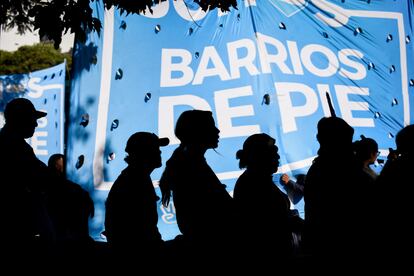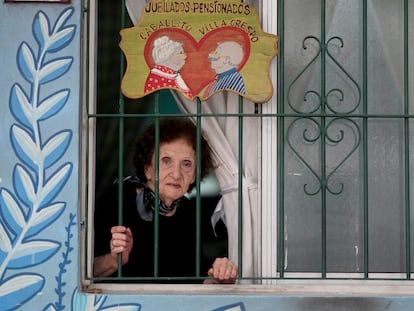Argentina’s economic crisis revives the specter of dollarization
Soaring inflation and scarce foreign exchange has rekindled the debate about dumping the peso


Foreign exchange restrictions and the daily devaluation of the peso have turned the U.S. dollar into an obsession in Argentina. Newspapers and TV stations monitor exchange rates minute by minute; street money changers sort bills feverishly; and tiktokers and youtubers post videos on how to bleach dollar bills to keep them clean and crisp. Everyone puts their savings into dollars, and now real estate transactions are conducted in the U.S. currency. Even rentals and smaller transactions demand the coveted greenbacks. Argentina is a country with two currencies that keeps whatever dollars it can get under the mattress. Six months before the presidential elections, a far-right campaign proposal has fueled the flames of discontent: could Argentina emerge from this crisis if it dumps the peso and dollarizes the entire economy?
Javier Milei, the media-friendly libertarian legislator, says yes. Milei is rising in the polls over other conservative factions like the ruling Peronist party and the moderate right. In less than three years, he has jumped from making strident appearances on television to leading presidential polls. Milei has called for “burning down” the Central Bank and “taking a chainsaw” to public spending. He wants a new ban on abortion and to legalize the sale of human organs. In short, Milei is dominating the narrative and has pushed Argentina to debate the feasibility of dollarization even though politicians decided against it and almost 60% of the people in public opinion polls don’t agree with it either.
“Argentina is not in a position to undertake dollarization because this requires Central Bank dollar reserves it doesn’t have,” said economist Julián Zícari. “Trying to [dollarize] would cause a complete evaporation of wages and pensions.” Zícari, who wrote a book on the history of Argentina’s economic crises, says dollarization is a “very radical and desperate measure,” proposed by “fanatics that think that it’s best to blow everything up.”

Javier Milei has been making the rounds on television touting three radical economic measures: the elimination of the Central Bank, the privatization of state-owned enterprises, and a fiscal adjustment that would trim the GDP by 13 points. Milei believes that a dollarization process that adheres to the parallel market exchange rate (469 pesos per dollar in early May) is feasible if all the Central Bank’s assets and liabilities are liquidated. Other economists from the government, opposition parties and independent organizations are less optimistic and believe dollarization will cause hyperinflation that would shoot the price of the dollar up to 8,000 pesos.
“The logistics of dollarization would be very complex. To begin with, all the pesos in circulation would have to be bought up for a very low dollar amount”, said Emiliano Libman, an economist and researcher with the Fundar organization. Libman doesn’t believe dollarization is impossible, although the only parallel example in Argentina’s recent history was traumatic. In 1990, when inflation reached 2,314%, a convertibility plan pegged the dollar to 10,000 australes, the Argentine currency. In 1992, the austral became a convertible peso that was pegged at par value with the U.S. dollar. Carlos Menem’s administration sustained the convertibility regime with foreign debt and the privatization of state-owned enterprises, but by 1997, the initiative was floundering. The convertibility regime finally sank in December 2001 during the “corralito” crisis, the informal name for the government’s economic measures.
“The dollarization debate is getting traction because of the situation we are facing in Argentina, which is not at all good. But it’s unrealistic to think dollarization is a magic solution because it leaves you with no instruments to use in unfavorable external conditions,” said Libman. “For example, a [dollarized] economy cannot adjust to a sinking dollar by modifying the exchange rate; it can only adjust through recession. And we already went through one that couldn’t save the convertibility regime.”
Zícari is unequivocal. “Dollarization is a delirium that would end up turning the nation into a colony of another country that defines your monetary policy,” he said, referring to how the U.S. Federal Reserve uses interest rate hikes to curb inflation and address banking crises. “You would be left with no exchange rate policy and a very limited fiscal policy options. And forget about any industrial development programs.”
Argentina is nearly unanimous in believing that dollarization is not feasible, but the ongoing discussion proves its effectiveness for the far-right’s political ambitions. In early May, Cristina Kirchner spoke at a rally where her supporters expected some announced about her plans for the next elections. Instead, the vice-president gave the crowd a historical review of the convertibility crisis. Without saying his name, Kirchner attacked Javier Milei’s dollarization ideas. “Everyone is talking about something that failed 20 years ago,” she said. “How are these politicians going to convince anyone that they can control the economic powers and solve all of Argentina’s problems? Enough of these fantasies!”
But the fantasy has undoubtedly made an impression on the Argentine people. The dollar is part of their daily lives, whether it’s the official foreign exchange market, the parallel market on the streets, or the dollarization of transactions in real estate and used electronics. “Saving in dollars is common and reflects how many Argentines have the capacity to save. In other words, tell me how many Argentines can save and I will tell you the amount of dollars savings in the country,” said Libman. “Current conditions stoke this debate, but they can also serve to strengthen the peso.”
“We should not be reinventing the wheel,” said Libman, who is developing proposals with Fundar to lead the country out of this dual currency situation and reestablish the peso. “It may take decades, but some of our neighbors achieved it. To have an orderly macro-economy with low and stable inflation, we should not finance national budgets by putting more money into circulation all the time. We should not abuse this instrument. That’s something Argentina hasn’t tried yet.”
Sign up for our weekly newsletter to get more English-language news coverage from EL PAÍS USA Edition
Tu suscripción se está usando en otro dispositivo
¿Quieres añadir otro usuario a tu suscripción?
Si continúas leyendo en este dispositivo, no se podrá leer en el otro.
FlechaTu suscripción se está usando en otro dispositivo y solo puedes acceder a EL PAÍS desde un dispositivo a la vez.
Si quieres compartir tu cuenta, cambia tu suscripción a la modalidad Premium, así podrás añadir otro usuario. Cada uno accederá con su propia cuenta de email, lo que os permitirá personalizar vuestra experiencia en EL PAÍS.
¿Tienes una suscripción de empresa? Accede aquí para contratar más cuentas.
En el caso de no saber quién está usando tu cuenta, te recomendamos cambiar tu contraseña aquí.
Si decides continuar compartiendo tu cuenta, este mensaje se mostrará en tu dispositivo y en el de la otra persona que está usando tu cuenta de forma indefinida, afectando a tu experiencia de lectura. Puedes consultar aquí los términos y condiciones de la suscripción digital.
More information
Archived In
Últimas noticias
Most viewed
- Reinhard Genzel, Nobel laureate in physics: ‘One-minute videos will never give you the truth’
- Oona Chaplin: ‘I told James Cameron that I was living in a treehouse and starting a permaculture project with a friend’
- Pablo Escobar’s hippos: A serious environmental problem, 40 years on
- Chevy Chase, the beloved comedian who was a monster off camera: ‘Not everyone hated him, just the people who’ve worked with him’
- Why we lost the habit of sleeping in two segments and how that changed our sense of time










































